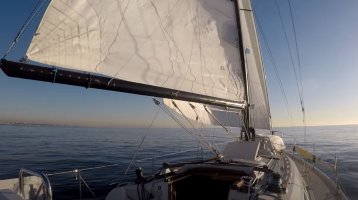Would we be getting the same speed with only a 135?
Hard to windward in a breeze, a big foresail on an E38 requires the boat maintain proper heel, or you get too much weather helm and it becomes a struggle. A medium size--120 to 130 overlap -- costs very little if any in speed and makes everything easier.
A big genoa comes into its own for reaching, when you can carry more sail. But it is of lighter sailcloth, in order to set in 6 knots of breeze, and therefore overstressed if reefed in heavy air. Today's variety of asymetrical spinnakers are better at reaching than any genoa jib.
To my mind, one size roller-furler jib has to fit all. Changing furler headsails is no fun, especially under way--even for racing crews. Err on the side of smaller.
Regarding design, I had a deck-sweeper Genny, which looked cool. My sailmaker talked me into a high clew. I find it better in every way, not just for visibility but in the tolerance of different sheeting angles when reefing.
Here's what a 120 percent overlap high-clew genoa looks like on an E381. It's 425 square feet, still 10 percent larger than the mainsail:


